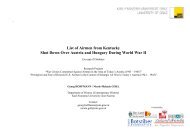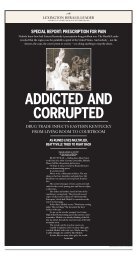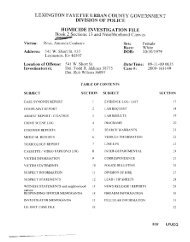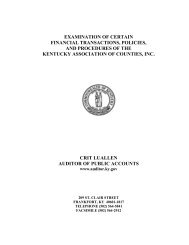Response to motion for summary judgment - Kentucky.com
Response to motion for summary judgment - Kentucky.com
Response to motion for summary judgment - Kentucky.com
Create successful ePaper yourself
Turn your PDF publications into a flip-book with our unique Google optimized e-Paper software.
as of 1:30 a.m., that defendant noted that Grady was awake and sitting up on the bench in his cell.<br />
Id. at 1004-1005. At approximately 1:50 a.m., that Defendant went <strong>to</strong> retrieve Grady from his cell<br />
and discovered him unresponsive on the floor. Id. at 1005. According <strong>to</strong> the paramedics who<br />
arrived at the lock-up, Grady had an abrasion on his <strong>for</strong>ehead and nose, and a bandage on his right<br />
hand. Id. Although the au<strong>to</strong>psy revealed that Grady’s cause of death was a natural case of coronary<br />
heart disease, it also noted a bloody bandage covering a quarter inch deep laceration between Mr.<br />
Grady’s right hand middle and ring fingers; a .2 inch abrasion on the <strong>to</strong>p of Grady’s right wrist; a<br />
four-by-two inch bruise at the left clavicle; and two abrasions on Grady’s <strong>for</strong>ehead that could have<br />
been caused by falling down or by being struck. Id. at 1005-1006. Based on these facts, the plaintiff<br />
claimed that the three lock-up officers beat Grady while he was in his cell without any justification.<br />
The district court relied on a Seventh Circuit case, Abdullahi v. City of Madison, which stated: “‘The<br />
award of <strong>summary</strong> <strong>judgment</strong> <strong>to</strong> the defense in deadly <strong>for</strong>ce cases may be made only with particular<br />
care where the officer defendant is the only witness left alive <strong>to</strong> testify ... so a court must undertake<br />
a fairly critical assessment of ... the officer’s original reports or statements.’” Id. at 1008 (citing<br />
Abdullahi v. City of Madison, 423 F.3d 763, 772 n.7 (7 th Cir. 2005). The district court held:<br />
Based on the pictures submitted <strong>to</strong> this Court illustrating the severity of Mr. Grady’s<br />
injuries and the lack of any documentation of Mr. Grady’s injuries by the police, a<br />
reasonable factfinder might conclude that Mr. Grady sustained his injuries while in<br />
police cus<strong>to</strong>dy. ...<br />
Moreover, the medical evidence presented by Moore raises issues of fact about the<br />
manner in which Mr. Grady was injured and the time at which he actually received<br />
his injuries. Dr. Kaufman, the doc<strong>to</strong>r hired <strong>to</strong> do the second au<strong>to</strong>psy on Mr. Grady,<br />
stated that the injuries <strong>to</strong> Mr. Grady’s head were consistent with blunt <strong>for</strong>ce trauma<br />
and the injury <strong>to</strong> Mr. Grady’s hand was consistent with a defensive wound. Dr.<br />
Patrick Besant-Matthews, a <strong>for</strong>mer medical examiner and expert witness <strong>for</strong> the<br />
Plaintiff, stated that the laceration on Mr. Grady’s hand would have bled significantly<br />
and would have been painful from the moment it occurred. Dr. Besant-Matthews<br />
36







